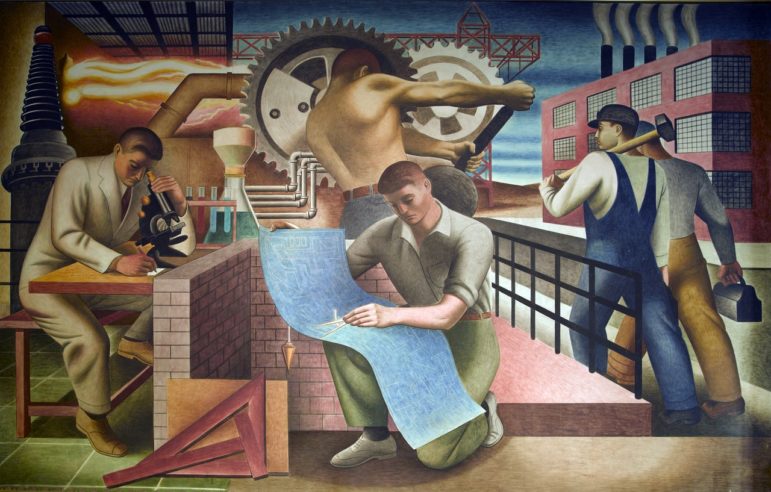
WPA
A New Deal-era WPA mural at the Cohen Building in Washington, D.C. In the Great Depression, art was used to bind together a nation in crisis. The time has come to again, the author writes below, look to art as a tool for rebuilding.
The case for investing in arts and culture to drive economic and social progress has been made. Now is the time to act on it.
Eighty years ago the Works Progress Administration (WPA) of the 1930s was started by the federal government to address unemployment. But the WPA’s five arts programs were its largest, employing artists to create or perform works that embodied the spirit of recovery from the Great Depression. It sustained remarkable artists such as Willem de Kooning, Richard Wright, Ralph Ellison, Burt Lancaster, Zora Neale Hurston, Lee Krasner, and many more.
In the late 1970s came the Comprehensive Employment and Training Act (CETA), created to address unemployment and strengthen public infrastructure by training and employing thousands in new public service jobs. Resourceful artists and administrators made it the largest federally-funded investment in the arts since the WPA.
Here in New York City, under the Cultural Council Foundation, the CETA Artists’ Project operated as a pipeline for talented artists, sharing their work with diverse audiences across Gotham. In New York City alone, between 1977 and 1982, federal CETA funds supported 350 artists to contribute their art to our community: creating public art, making theater that spoke to the issues of the day, teaching dance workshops, sharing poetry in hospitals, schools, and senior centers.
I was among those who took part in the cultural renaissance sweeping across 1970s New York thanks to CETA. I started out directing poet’s theater at the St. Mark’s Poetry Project. That CETA job in 1979—the same year I published my first book—supported my work as Coordinator, host, and workshop leader at The Poetry Project. Receiving public support for arts projects was critical in my making my way as a poet, and for my generation, it helped to mitigate the mistrust developed during Vietnam. It also helped shape a generation of artists to be voices of understanding in turbulent times.
In 2017, we face new uncertainties. Our nation is roiling from the effects of the 2016 campaign, widespread foreboding, and uncertainty. The president has a responsibility to address the pervasive undercurrent of dis-belonging and hate. As Minister of Poetry and Language Protection on the National Cabinet of the U.S. Department of Arts and Culture (USDAC), I know there’s a way for the people to leverage the arts to strengthen our bonds and nurture cultural understanding.
Last November, we launched Standing for Cultural Democracy: The USDAC’s Policy and Action Platform, a ten-point program based on ideas shared by thousands of Americans who were invited to tell their stories—an act of collective imagination by, for, and of the people.
They spoke of jobs leaving the country, crumbling infrastructure, neighbors divided by economic pressure and fear. We listened and created a policy-based platform to address those challenges. From calling for universal basic income to addressing gentrification through cultural impact studies (CISs), the USDAC is advancing these concepts as solutions to the challenges we face on the state, local, and federal levels.
We’re encouraged by past and present experiments. At its height in the ’70s, CETA spent $200 million on arts jobs across the nation (about $665 million in 2016 dollars). Forty years later, in 2015, New York’s Department of Cultural Affairs began supporting artists-in-residence at a range of public bureaus, including the Mayor’s Office of Immigrant Affairs, the Department of Design and Construction, the Administration for Children’s Services and the Department of Veterans’ Services, a small program that is expected to grow. It has already proven worthy of being taken to national scale.
Our nation is plowing huge sums into corporate tax-breaks and the world’s largest prison system. Since 2001, the United States has spent more than $8 million an hour on the War on Terrorism. With a federal budget of nearly $4 trillion, why not allocate $1 billion—a tiny fraction of one percent—for jobs that nurture cultural democracy and reduce strife?
If President Trump truly wants to truly heal our nation and put it back to work, he needs smart, effective strategies for building cultural understanding. I urge him to start with artists, one of our country’s great natural resources. Practicing the empathy, creativity, and social imagination needed to strengthen our bonds following November’s election, we can save our communities, rural and urban, and shape a livable, more equitable future.
In fact, I’d like to see him start with a resident poet in the White House, as in the T’ang Dynasty, when poets were appointed to every court. (NB: they could not be fired.) I think he could use one.








